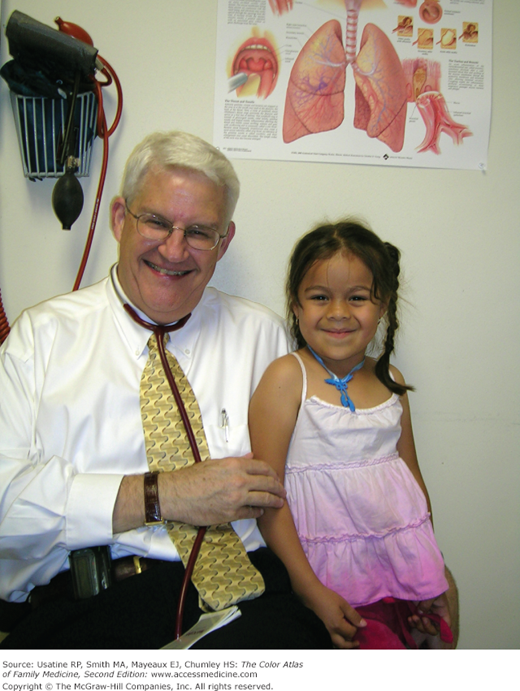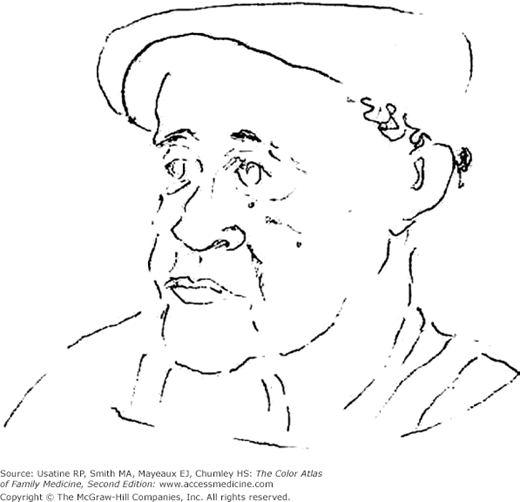Doctor—Patient Relationship: Introduction
Patient Story
Patient stories, particularly if we listen attentively and nonjudgmentally, provide us with a window into their lives and experiences. These stories help us to know our patients in powerful ways, and that knowledge about the patient, as someone special, provides the context, meaning, and clues about their symptoms and illnesses that can lead to healing. At our best, we serve as witness to their struggles and triumphs, supporter of their efforts to change and grow, and guide through the medical maze of diagnostic and therapeutic options. Sometimes, their stories become our own stories—those patients who we will never forget because their stories have changed our lives and the way we practice medicine (Figure 2-1).
Figure 2-1
Dr. Jim Legler caring for a young girl in a free clinic within a transitional housing village for homeless families. He is a family physician who volunteers every week to care for the 40 families working their way out of homelessness. He had been caring for Kimberly and her family for many months at the time this photograph was taken. Dr. Legler serves as a role model for students interested in primary care of the underserved. He is known for his kindness and compassion to all his patients.
What Patients Want from Their Physician
As part of the future of family medicine (FFM) initiative, telephone interviews of the general public (N = 1031) were conducted in 2002.1 Most patients strongly agreed that they wanted to take an active role in their healthcare (82% and 91%, patients with family physicians and patients with general internists, respectively), they wanted their physicians to treat a wide variety of medical problems but refer to a specialist when necessary (88% and 84%), and they wanted a physician who looks at the whole person—emotional, psychological, and physical (73% and 74%). In addition, of 39 possible attributes of physicians, most patients (68% to 97% stated extremely or very important) viewed the following as the most important attributes/services that drive overall satisfaction with their physician:
- Does not judge; understands and supports.
- Always honest, direct.
- Acts as partner in maintaining health.
- Treats both serious and nonserious conditions.
- Attends to emotional and physical health.
- Listens to me.
- Encourages healthier lifestyle.
- Tries to get to know me.
- Can help with any problem.
- Someone I can stay with as I get older.
What Physicians Want from and for Patients
Although the types and intensity of relationships with patients differ, our positive and negative experiences with patients shape us as clinicians, influence us in our personal relationships, and shape the character of our practices. Arthur Kleinman, in his prologue to Patients and Doctors: Life-Changing Stories from Primary Care, wrote, “We all seem to want (or demand) experiences that matter, but maybe what is foremost is that we want experiences in which we matter.” There is perhaps no greater satisfaction than the beliefs that what we do and who we are matters to those we care for in both our personal and professional lives.2 A positive relationship with a patient is one of mutual growth. This concept of doctor-patient reciprocity is not new and can be found in the writings of Erasmus, more than 500 years ago, arising from a classical conception of friendship.3
As clinicians we want patients to be healthier and improved in some meaningful way after our encounter with them. Meaningful elements common to healing practices across cultures include:4
- Providing a meaningful explanation for the sickness.
- Expressing care and concern.
- Offering the possibility of mastery and control over the illness or its symptoms.
Family physicians (N = 300) who were interviewed as part of the FFM initiative stated that the following things completely captured the essence of what they found as most satisfying about being a family physician:1
- The deep relationships developed with patients over the years (54%).
- The variety—no day is ever the same (54%).
- Offers me a strong sense of purpose because I can make a real difference in people’s lives (48%).
- Don’t spend their days taking care of illness, but take care of the whole patient (Figure 2-2) (46%).
Figure 2-2
Dr. Alan Blum is a family physician who has been doing sketches of his patients for decades now. When he presents his drawings of his patients, he reads his poetic stories that go with the drawings. Some of his drawings have been published in JAMA. Here is the poem that goes with this man’s story:
- “Gov’ment gave me a chance
- to get a hearin’ aid for free.
- But when I went to th’ doctor,
- he say,
- ‘Well, cap’n,
- there gonna be a lot o’ things
- you don’t want to hear!’”
Learning from Patients
- Move outside of their worldview and accept the patient’s point of view and belief system.
- Let go of stereotypes, biases, and dogma.
- Use active empathic listening, see the patient in context, and adopt reflective and reflexive practices.5

Stay updated, free articles. Join our Telegram channel

Full access? Get Clinical Tree




